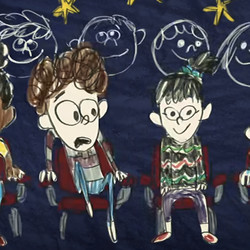Like many animated movies in the last couple of years, Netflix and DreamWorks’ Orion and the Dark steps outside the design conventions that had come to define American CG movies. The stylistic revolution has really taken off as animators battle the slick perfection built into past computer-animation algorithms. And their yearning toward more creatively stylized animation has been emboldened by the huge success of Spider-Man: Into the Spider-Verse.
“I think people are just looking for something new,” says Sean Charmatz, director of Orion and the Dark. “We’ve all seen the CG film, and it’s clean and it’s beautiful. It’s shiny. [But] you’ll see [movies] from Spider-Verse to Mitchells to Turtles recently, doing this really inventive stuff. As long as [your chosen style] fits with what you’re trying to do, and the story you’re trying to tell, I think you get some really, really cool moments. I don’t think any of us want to [change our animation style] just to do it, just to kind of come up with something cool. It’s got to fit.”
For Orion and the Dark, the inspiration was clear. The movie, scripted by Eternal Sunshine of the Spotless Mind and Being John Malkovich writer Charlie Kaufman, follows a very anxious young boy who meets the personification of darkness and starts to get over his fears. The story comes from Emma Yarlett’s picture book of the same name. Charmatz and producer Peter McCown really wanted to capture the charm of Yarlett’s original illustrations and get the feel of pencil on paper. Even though the majority of the movie is rendered in CG, it still has a specific textured and stylized look: a “little bit handcrafted,” as Charmatz puts it.
The homage to the original drawings goes beyond that, with scenes from Orion’s sketchbook coming to life and playing out as Orion gets lost in his own head and the pages turn, illustrating his worst fears in childlike drawings. The pencil-on-paper roots of animation are clearest in those sequences, and the drawings cement the story in Orion’s point of view. He’s the narrator of the story, after all, an anxious young boy who processes his fears through his drawings. Having those doodles come to life was important for the filmmakers. But when they approached the 2D animation they wanted for those scenes, they were presented with a unique challenge.
“Most everyone is CG-based now,” explains Charmatz. “When you ask someone to do 2D, it almost feels like, What?”
“You gotta get some of the older generation,” adds McCown.
“[It was like] people going into their garage and taking a box out to do the job because they haven’t touched that stuff [in years],” says Charmatz. “But honestly, it wasn’t too much of a challenge, because we had Emily Tetri designing the drawings, and she was so good at making the drawings feel authentic and like a kid drew them.”
The style in the sketchbook sequences is done in “boiling line animation,” where the individual lines of the drawing wriggle, suggesting just a touch of nervous instability or fragility. It’s achieved by repeatedly tracing an original drawing, then compositing the tracings together as individual frames. Charmatz says the actual process was pretty simple, once everyone metaphorically dusted off those old skills. These doodle scenes also were particularly special because they directly put Tetri’s drawings on the screen, which isn’t the case in most animated movies.
“You never, ever see one-for-one drawings — the drawing that the artist did, and that’s what’s on screen,” says Charmatz. “But there’s like 10 minutes of Emily’s one-for-one drawings in the film. And I think that’s really cool.”
Orion and the Dark hits Netflix on Feb. 2.



